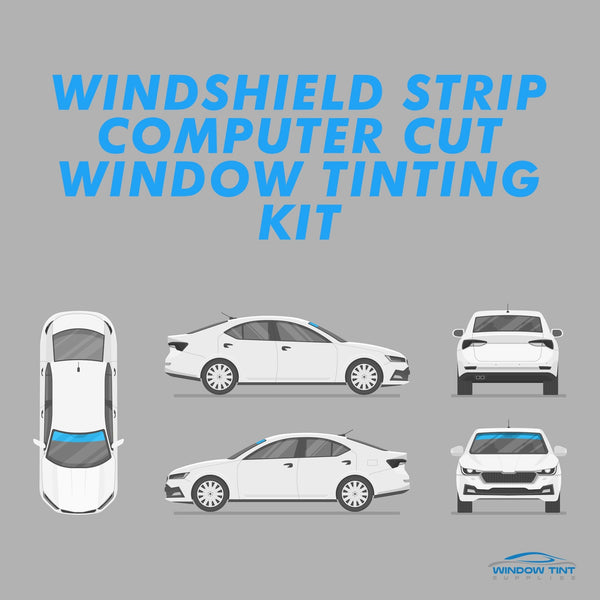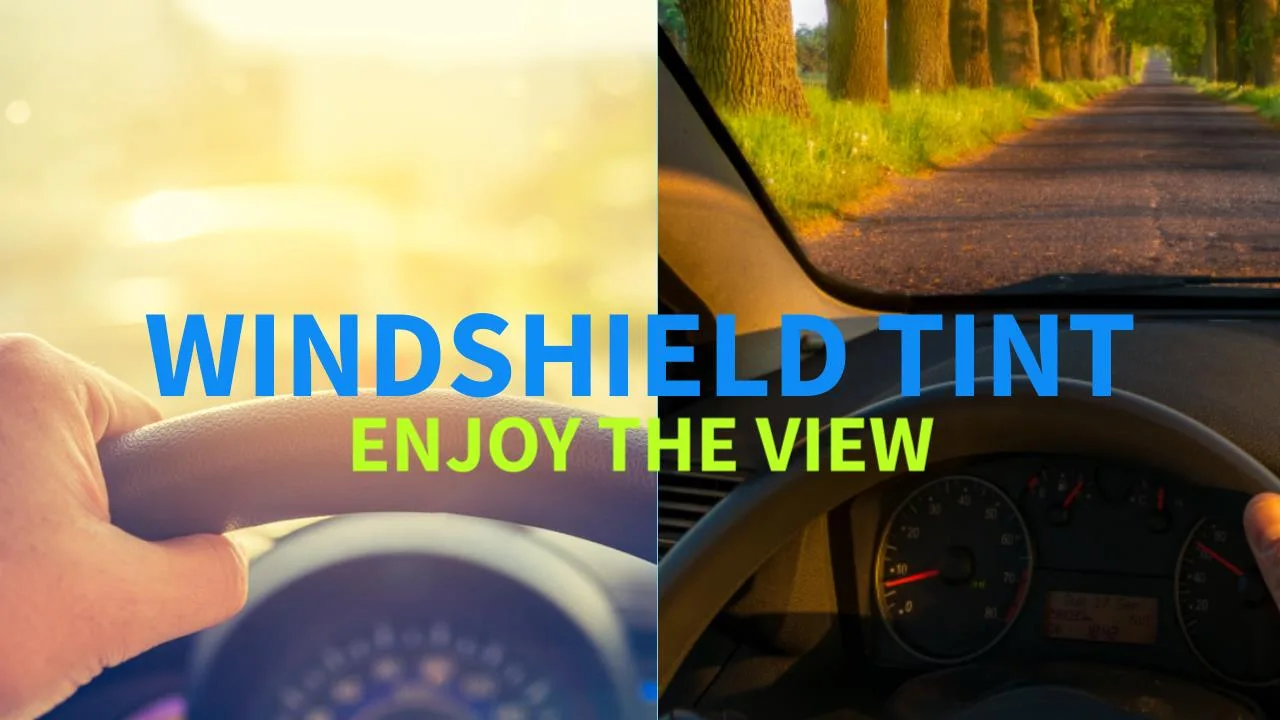Whatever You Need to Understand About Windscreen Tinting for Your Lorry
Windscreen tinting is a useful enhancement for vehicles, providing different benefits that lots of owners might neglect. It gives benefits like UV security and temperature level control. The options readily available are huge, and the lawful landscape can be complicated. Comprehending the kinds of colors and installment procedures is necessary for making informed decisions. As the discussion unfolds, it comes to be clear that there is far more to contemplate prior to waging windscreen tinting.

Advantages of Windscreen Tinting
Some vehicle proprietors may neglect windscreen tinting, its benefits are substantial. One of the primary benefits is improved UV protection. Colored windscreens can obstruct as much as 99% of unsafe ultraviolet rays, minimizing the risk of skin damages for passengers and maintaining the automobile's inside from fading and cracking. Windscreen tinting can enhance driving convenience by decreasing glow from the sun, which can be a safety and security threat. This reduction in glare permits much better exposure and a much more delightful driving experience.Additionally, windshield tinting adds to temperature level control within the lorry. By showing sunlight, it aids maintain a cooler cabin, resulting in decreased dependence on air conditioning and improved fuel efficiency. Finally, privacy is one more advantage, as colored windshields supply a degree of cover-up from spying eyes, enhancing safety for individual valuables. On the whole, the benefits of windshield tinting make it a beneficial consideration for lorry owners.
Types of Windshield Tints
When selecting windshield tints, car proprietors encounter a variety of options, each offering distinct qualities and benefits. Windshield Tinting Newark. The most common types consist of colored, metalized, and ceramic colors. Colored tints are preferred for their visual charm and capability to reduce glare, but they may discolor with time. Metalized colors integrate small metal bits that improve warm rejection and increase sturdiness, although they can disrupt digital signals. Ceramic colors are understood for their high performance, providing superb UV defense and warm being rejected without signal interference, making them a costs option. Additionally, some manufacturers supply hybrid choices that combine the advantages of metalized and colored tints, offering an equilibrium of appearances and functionality. Each kind of color varies regarding performance, rate, and appearance, allowing lorry owners to select based upon their certain needs and choices. Understanding these options is crucial for making a notified choice
Lawful Regulations for Windshield Tinting
Legal guidelines pertaining to windshield tinting differ significantly by state, with each territory imposing certain exposure needs. Compliance with these regulations is vital to avoid legal charges, which can consist of mandates or fines to remove non-compliant tinting. Recognizing the subtleties of these regulations can help vehicle owners make educated choices regarding their tinting choices.
Tinting Regulations by State
What policies regulate windscreen tinting across the United States? Windshield tinting legislations differ significantly from one state to another. Each state develops specific guidelines relating to the permissible levels of tint darkness, the kinds of movies permitted, and the areas on the windscreen where tinting can be applied. For instance, some states permit a specific percent of Visible Light Transmission (VLT) for the upper windshield strip, while others may have stricter limitations or outright restrictions. Additionally, states might differ in their enforcement of these laws, with some allowing exemptions for medical reasons. Vehicle proprietors must acquaint themselves with their state's regulations to avoid penalties and warranty conformity when thinking about windshield tinting options for their vehicles.
Exposure Needs

Legal Penalties for Violations
Failure to abide by windscreen tinting policies can cause considerable lawful fines for car proprietors. The majority of states implement certain legislations pertaining to the allowable color percent and reflectivity on windscreens. Offenses might lead to fines, which can differ widely relying on the jurisdiction. In some cases, police may provide a citation, requiring the vehicle owner to remedy the tinting within a defined duration. Repeated offenses could lead to enhanced fines or perhaps factors on the chauffeur's certificate. Additionally, incorrectly colored windshields can lead to the automobile falling short assessments, possibly resulting in additional fines. It is important for automobile proprietors to acquaint themselves with local legislations to stay clear of unneeded legal complications and assurance conformity with tinting laws.
Installment Process and Tips
Setting up windshield tint needs mindful prep work and focus to information to safeguard an expert surface. The process begins with choosing the proper color movie that adheres to neighborhood regulations. Once chosen, the car must be parked in a tidy, dust-free environment to decrease impurities throughout installation.Next, the windshield should be completely cleaned up to eliminate any type of dirt, grease, or deposits that can conflict with adhesion. Using a spray container loaded with a mix of water and a few drops of soap can aid oil the surface area before using the tint.The movie is after that very carefully determined and cut to fit the windshield, permitting a mild overlap at the sides. After positioning the film, it ought to be squeegeed to eliminate air bubbles and safe and secure correct adherence. Trimming the excess film and permitting it to treat are important steps for a smooth finish.
Upkeep and Treatment for Tinted Windshields
Maintaining tinted windshields is crucial for protecting their appearance and capability in time. Regular cleansing is vital; making use of a soft microfiber fabric and a gentle auto glass cleaner helps protect against scratches and keeps clearness. It is recommended to stay clear of ammonia-based cleaners, as they can weaken the tint.Additionally, routine inspections for any indications of peeling off or bubbling must be performed. Attending to these issues immediately can prevent additional damages. Auto parking in shaded locations or utilizing sunshades can assist minimize sun direct exposure, decreasing the threat of fading.Furthermore, drivers must be mindful when using tools or devices that might unintentionally speak to the tinted surface. Mindful handling, especially when cleaning up or applying protective movies, can expand the life-span of the tint. By adhering to these maintenance practices, automobile proprietors can assure their colored windshields remain both functional and aesthetically appealing for years to come.
Typical Myths Regarding Windshield Tinting
Lots of false impressions border windshield tinting, particularly concerning lawful restrictions and the effectiveness of warm reduction. Recognizing the actual laws governing tint levels can aid car owners make notified choices (Windshield Tinting Newark). Furthermore, it is essential to make clear just how much warm tinting can genuinely minimize inside an automobile
Lawful Limitations Discussed
What are the typical mistaken beliefs surrounding the legal restrictions of windshield tinting? Numerous individuals believe that any level of color on a lorry's windscreen is allowable, causing confusion and potential penalties. In truth, legislations vary substantially by state, with certain guidelines dictating the allowable percent of noticeable light transmission (VLT) Some presume that darker colors offer complete personal privacy; nevertheless, this frequently leads to lawful consequences if the color surpasses local restrictions. In addition, misunderstandings exist concerning the kinds of tint film that are lawful; as an example, reflective colors may have more informative post stringent laws. Understanding these lawful specifications is essential for automobile owners to assure and prevent fines compliance while accomplishing their desired visual.
Warmth Reduction Misconceptions
Countless misunderstandings border the effectiveness of windscreen tinting in decreasing warmth inside cars. A typical misconception recommends that all tints considerably reduced temperatures, however efficiency differs by the type and high quality of the movie used. Furthermore, some think that darker colors always offer far better warmth reduction; nevertheless, progressed metal and ceramic movies can provide premium performance without extreme darkness. One more misconception is that tinting exclusively obstructs sunshine; in truth, it can likewise mirror infrared rays in charge of heat. Several think that windscreen tinting is only useful in bright environments, overlooking its benefits in lowering warmth also in cooler areas. Understanding these myths is necessary for consumers to make educated choices about windshield tinting.
Frequently Asked Questions
Will Windshield Tinting Impact My Car's Resale Worth?
The influence of windscreen tinting on a vehicle's resale value varies. Some potential buyers might value the added privacy and UV defense, while others could see it as an adjustment that detracts from the car's appeal.
Can I Use Tint Over an Existing Factory Tint?
Using tint over an existing manufacturing facility tint is feasible, but it may cause difficulties such as bubbling or peeling go right here off. It is very important to speak with a specialist to guarantee the most effective results and adherence to lawful regulations.
For How Long Does Windshield Color Last?
Windshield color generally lasts in between five to ten years, relying on the quality of the movie, installation, and ecological factors. Appropriate upkeep can extend its life expectancy, preserving both appearance and performance against UV rays and heat.
Is Windscreen Tinting Safe for All Kinds Of Automobiles?
Windscreen tinting safety and security varies by car kind and neighborhood policies. While numerous automobiles can take advantage of tinting, certain designs or problems may restrict its application, requiring mindful factor to consider of legal limitations and manufacturer guidelines.
Can I Eliminate Windscreen Color Myself if Needed?
Removing windshield tint can be a difficult job. It calls for mindful techniques to prevent harming the glass. Many individuals select specialist support, however experienced DIYers might successfully complete the process with the right devices and patience. Each state develops details standards regarding the allowable degrees of tint darkness, the types of films allowed, and the places on the windshield where tinting can be applied. Furthermore, some states forbid any type of tinting on the windshield except for a producer's tint band at the top. Some assume that darker tints provide complete personal privacy; nonetheless, this frequently leads to legal consequences if the tint surpasses regional restrictions. In anchor addition, misunderstandings exist concerning the types of tint movie that are lawful; for circumstances, reflective colors may have more stringent guidelines. Using tint over an existing manufacturing facility tint is possible, but it might lead to complications such as peeling or bubbling.